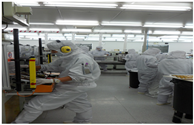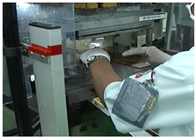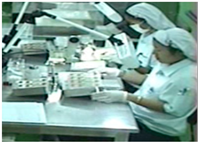Semi-Quantitative Risk Assessment of Occupational Back Pain and Its Associated Risk Factors Among Electronics Assembly Workers
Abstract
1. Introduction
2. Materials and Methods
2.1. Population and Sample Size
2.2. Research Tools
2.2.1. Work Characteristics Questionnaire and the Musculoskeletal Disorders (MSDs) Severity and Frequency Questionnaire (MSFQ)
2.2.2. Ergonomic Risk
2.2.3. Semi-Quantitative Matrix of Health Risk Assessment for Predicted Occupational Back Pain
2.2.4. Measurement of Lighting Intensity
- The tasks involving machine operation and material input/handling into machines that used elastomers, which were block molding, cutting, stamping, bending, pressing, and plastic forming, were measured and compared to the lighting intensity standard of 200–300 lux.
- The tasks related to materials assembly, which included gluing, marking, packing, taping, and soldering, were measured and compared to the lighting intensity standard of 400–500 lux.
- General inspection tasks involving a computer monitor or profile projector were measured by performing 1–2 spot measurements. The average of these measurements was representative of the lighting intensity at the stations where workers focused their eyes. These results were then compared to the lighting standard of 500–600 lux. In addition, inspections conducted with a lamp were measured in the inspection area and compared to the medium fine work standard of 500–600 lux.
- Inspection with a microscope depends on the lighting intensity adjustment. The lighting intensity was compared with the standard of fine work (800 to 1000 lux) in zone 1 (the eye-focusing work zone). If the lighting intensity in zone 1 reached a value higher than 1000 lux, it meant that further measurements in zone 2 and zone 3 were carried out [17,18].
2.3. Statistical Analysis
3. Results
3.1. Personal and Work Characteristics
3.2. Lighting Intensity
3.3. Workload and Ergonomic Risk
3.4. Potential Health Risk of Predicted Back Pain
3.5. Factors Correlated with Predicted Back Pain According to Multiple Logistic Regression Analysis
4. Discussion
4.1. Occupational Health Risk of Predicted Back Pain
4.2. Factors Correlated with Back Pain
4.2.1. Personal Factors
4.2.2. Work Characteristics and Work Stress Factor
4.2.3. Work Environment and Ergonomic Factors
5. Conclusions
Author Contributions
Funding
Institutional Review Board Statement
Informed Consent Statement
Data Availability Statement
Conflicts of Interest
References
- Meisha, D.E.; Alsharqawi, N.S.; Samarah, A.A.; Al-Ghamdi, M.Y. Prevalence of work-related musculoskeletal disorders and ergonomic practice among dentists in Jeddah, Saudi Arabia. Clin. Cosmet. Investig. Dent. 2019, 11, 171–179. [Google Scholar] [CrossRef]
- Social Security Office. Compensation Fund Statistics. 2024. Available online: https://www.sso.go.th/wpr/main/privilege (accessed on 12 December 2024).
- Health Data Center. Ministry of Public Health. Occupational Diseases 2024. Available online: https://hdc.moph.go.th/center/public/search (accessed on 12 December 2024).
- Yang, F.; Di, N.; Guo, W.W.; Ding, W.B.; Jia, N.; Zhang, H.; Li, D.; Wang, D.; Wang, R.; Zhang, D.; et al. The prevalence and risk factors of work-related musculoskeletal disorders among electronics manufacturing workers: A cross-sectional analytical study in China. BMC Public Health 2023, 23, 10. [Google Scholar] [CrossRef]
- Inoue, G.; Uchida, K.; Miyagi, M.; Saito, W.; Nakazawa, T.; Imura, T.; Shirasawa, E.; Akazawa, T.; Orita, S.; Inage, K.; et al. Occupational characteristics of low back pain among standing workers in a Japanese manufacturing company. Workplace Health Saf. 2020, 68, 13–23. [Google Scholar] [CrossRef] [PubMed]
- Chaiklieng, S.; Suggaravetsiri, P. Low back pain (LBP) incidence, ergonomics risk and workers’ characteristics in relations to lbp in electronics assembly manufacturing. Ind. J. Occup. Environ. Med. 2020, 24, 183–187. [Google Scholar] [CrossRef] [PubMed]
- McAtamney, L.; Corlett, E.N. RULA: A survey method for the investigation of work-related upper limb disorders. Appl. Ergon. 1993, 24, 91–99. [Google Scholar] [CrossRef]
- Hignett, S.; McAtamney, L. Rapid Entire Body Assessment (REBA). Appl. Ergon. 2000, 31, 201–205. [Google Scholar] [CrossRef] [PubMed]
- Kee, D. Comparison of OWAS, RULA and REBA for assessing potential work-related musculoskeletal disorders. Int. J. Ind. Ergon. 2021, 83, 103140. [Google Scholar] [CrossRef]
- Kee, D.; Na, S.; Chung, M.K. Comparison of the ovako working posture analysis system, rapid upper limb assessment, and rapid entire body assessment based on the maximum holding times. Int. J. Ind. Ergon. 2020, 77, 102943. [Google Scholar] [CrossRef]
- Chee, H.L.; Rampal, K.G.; Chandrasakaran, A. Ergonomic risk factors of work processes in the semiconductor industry in Peninsular Malaysia. Ind. Health 2004, 42, 373–381. [Google Scholar] [CrossRef]
- Chaiklieng, S.; Suggaravetsiri, P.; Pruktharathikul, V. Risk factors for developing occupational back pain in electronics industry workers: A cross-sectional study. Safety 2024, 10, 90. [Google Scholar] [CrossRef]
- Chaiklieng, S. Health risk assessment on musculoskeletal disorders among potato-chip processing workers. PLoS ONE 2019, 14, e0224980. [Google Scholar] [CrossRef]
- Hsieh, F.Y.; Bloch, D.A.; Larsen, M.D. A simple method of sample size calculation for linear and logistic regression. Stat. Med. 1998, 17, 1623–1634. [Google Scholar] [CrossRef]
- Widanarko, B.; Legg, S.; Devereux, J.; Stevenson, M. Gender differences in work related risk factor associated with low back pain symptoms. Ergonomic 2012, 55, 327–342. [Google Scholar] [CrossRef]
- Department of Labor Protection and Welfare, Ministry of Labor, Thailand. Notification of Rules, Procedures of Measurement and Condition Analysis, Analysis of Working Condition Related Hot, Light or Noise Including Period and Type of Business that Must Be Performed B.E. 2561 (A.D.2018); Royal That Gazette; 2018; Volume 135, p. 11, Special Episode 57. Available online: https://ratchakitcha.soc.go.th/documents/2135198.pdf (accessed on 28 October 2025).
- Chaiklieng, S. Lighting intensity monitoring at inspection workstations in electronics assembly and manufacturing. Univ. J. Public Health 2023, 11, 954–960. [Google Scholar] [CrossRef]
- Department of Labor Protection and Welfare, Ministry of Labor, Thailand. Notification of Light Intensity Standard, B.E.2561 (A.D.2018); Royal Thai Gazette; 2018; Volume 135, p. 15, Special Episode 39. Available online: https://ratchakitcha.soc.go.th./pdf (accessed on 21 February 2018).
- Kezhi, J.; Gary, S.S.; Theodore, C.K. Prevalence of low back pain in three occupational groups in Shanghai, people’s Republic of China. J. Saf. Res. 2004, 35, 23–28. [Google Scholar] [CrossRef]
- Maimaiti, N.; Wanga, J.; Jin, X.; Wang, S.; Qin, D.; He, L.; Wang, F.; Zhang, Z.; Forsman, M.; Yang, L.; et al. Cervical musculoskeletal disorders and their relationships with personal and work-related factors among electronic assembly workers. J. Saf. Res. 2019, 71, 79–85. [Google Scholar] [CrossRef] [PubMed]
- Hashempour, F.; Abarghouei, N.S. Evaluation, identification & control of ergonomic risk factors in electronics companies (case study engineering company Behpajooh). J. Ergon. 2018, 5, 1–8. [Google Scholar] [CrossRef]
- Chen, H.-M.; Huang, P.-Y.; Chuang, H.-Y.; Wang, C.-L.; Yang, C.-C.; Huang, P.-J.; Ho, C.-K. Association of low back pain with shift work: A meta-analysis. Int. J. Environ. Res. Public Health 2023, 20, 918. [Google Scholar] [CrossRef]
- Yahya, N.M.; Zahi, Z.M.N. Work-related musculoskeletal disorders (WMSDs) risk assessment at core assembly production of electronic components manufacturing company. IOP Conf. Ser. Mater. Sci. Eng. 2018, 319, 012036. [Google Scholar] [CrossRef]
- Magnavita, N.; Elovainio, M.; De Nardis, I.; Heponiemi, T.; Bergamaschi, A. Environmental discomfort and musculoskeletal disorders. Occup. Med. 2011, 3, 196–201. [Google Scholar] [CrossRef]
- Idkhan, A.M.; Baharuddin, F.R. Comfort temperature and lighting intensity: Ergonomics of laboratory room machine tools. Int. J. Environ. Eng. Educ. 2019, 1, 53–58. [Google Scholar] [CrossRef]
- Wulandari, S.; Hasan, M. Evaluation of ergonomic risk factors in pcb soldering workstations. J. Ind. Technol. Manag. 2022, 13, 292–299. [Google Scholar] [CrossRef]
- Setiawan, A.; Utami, P.; Wijono, S. Anthropometric Analysis and Workstation Design for Female Workers in the Electronics Industry. J. Ind. Eng. Res. 2022, 16, 132–138. [Google Scholar]
- Nasution, W.I.A.; Chaniago, S.N.; Tambunan, R.F.; Hasibuan, A. Evaluation of ergonomic risk factors in electronics factory and its impact on productivity: Literature study. J. Adv. Multidiscip. Stud. (JAMS) 2025, 1, 186–194. [Google Scholar]
- Kee, D.; Kamalinia, M.; Oliaee, M.; Daneshmandi, H. An ergonomic intervention to relieve musculoskeletal symptoms of assembly line workers at an electronic parts manufacturer in Iran. Work 2018, 61, 515–521. [Google Scholar] [CrossRef]
- Rampal, K.; Chee, H.L. The prevalence of musculoskeletal problems and risk factors among women assembly workers in the semiconductor industry. Med. J. Malays. 2013, 58, 657–666. [Google Scholar]
- Yazdanirad, S.; Khoshakhlagh, A.H.; Habibi, E.; Zare, A.; Zeinodini, M.; Dehghani, F. Comparing the effectiveness of three ergonomic risk assessment methods-RULA, LUBA, and NERPA-to predict the upper extremity musculoskeletal disorders. Ind. J. Occup. Environ. Med. 2018, 22, 17–21. [Google Scholar] [CrossRef]
- Tidaoon, P.; Chaiklieng, S. Health risk predicted matrix of MSDs risk assessment in electronic industrial workers of winding process. Ind. J. Occup. Environ. Med. 2025, 29, 124–129. [Google Scholar] [CrossRef]
- Hussain, F.; Uzair, M.; Islam, M.A.; Shafiq, M. Implementation of ergonomics and lean manufacturing principles to improve work environment and performance of soccer ball production line. J. Appl. Res. Technol. Eng. 2024, 5, 13–22. [Google Scholar] [CrossRef]
| Back Pain Risk | Level of Ergonomic Risk | ||||
|---|---|---|---|---|---|
| 1 | 2 | 3 | 4 | ||
| Level of back discomfort | 4 | 4 | 8 | 12 | 16 |
| 3 | 3 | 6 | 9 | 12 | |
| 2 | 2 | 4 | 6 | 8 | |
| 1 | 1 | 2 | 3 | 4 | |
| 0 | 0 | 0 | 1 * | 2 * | |
| Workstation | Example Task | n | Meet the Standard n (%) | Poor Lighting n (%) |
|---|---|---|---|---|
| A. Handling materials for machine input and operation |  | 53 | 34 (64.15) | 19 (35.85) |
| B. Operating a machine for assembly |  | 114 | 103 (90.35) | 11 (9.65) |
| C. Inspection of products using a lamp/magnifier |  | 72 | 61 (84.72) | 11 (15.28) |
| D. Inspection of products using a microscope |  | 115 | 27 (23.48) | 88 (76.52) |
| Total | 354 | 225 (63.56) | 129 (36.44) |
| Workstation | Ergonomic Risk Levels [Number (%)] | ||||
|---|---|---|---|---|---|
| 1 | 2 | 3 | 4 | 3–4 | |
| Handling materials for machine input and operation | 0 | 15 (28.30) | 21 (39.62) | 17 (32.08) | 38 (71.70) 1 |
| Operating a machine for assembly | 0 | 56 (49.12) | 48 (42.11) | 10 (8.77) | 58 (50.88) |
| Inspection of products using a lamp/magnifier | 0 | 24 (33.33) | 42 (58.33) | 6 (8.33) | 48 (66.66) 2 |
| Inspection of products using a microscope | 0 | 55 (47.83) | 57 (49.57) | 3 (2.61) | 60 (52.18) 3 |
| Back Pain Risk | Ergonomic Risk Level; n (%) | Total | ||||
|---|---|---|---|---|---|---|
| 1 | 2 | 3 | 4 | |||
| Back discomfort | 4 | 0 | 5 (1.41) | 5 (1.41) | 4 (1.13) | 14 (3.95) |
| 3 | 0 | 14 (3.95) | 18 (5.08) | 4 (1.13) | 36 (10.17) | |
| 2 | 0 | 48 (12.42) | 52 (14.69) | 13 (3.67) | 113 (31.92) | |
| 1 | 0 | 83 (24.57) | 47 (13.28) | 15 (4.24) | 145 (40.09) | |
| 0 | 0 | 0 | 46 (12.99) | 0 | 46 (12.99) | |
| Occupational Factor | Risk Level of Predicted Back Pain (n, %) | p-Value | |||
|---|---|---|---|---|---|
| 1 | 2 | 3 | 4 | ||
| Position | 0.584 | ||||
| Leader/Supervisor | 3 (33.33) | 6 (66.67) | 0 (0.0) | 0 (0.0) | |
| Operator | 130 (37.68) | 166 (48.12) | 36 (10.43) | 13 (3.77) | |
| Eye-focusing task | 0.003 * | ||||
| No | 58 (34.52) | 96 (57.14) | 12 (7.14) | 2 (1.19) | |
| Yes | 75 (40.32) | 76 (40.86) | 24 (12.90) | 11 (5.91) | |
| Manual lifting | 0.001 * | ||||
| No | 88 (37.13) | 127 (53.59) | 18 (7.59) | 4 (1.69) | |
| Yes | 45 (38.46) | 45 (38.46) | 18 (15.38) | 9 (7.69) | |
| Workstation | 0.020 * | ||||
| Appropriate | 120 (37.62) | 160 (50.16) | 30 (9.40) | 9 (2.82) | |
| Inappropriate | 13 (37.14) | 12 (34.29) | 6 (17.14) | 4 (11.43) | |
| Factor | Predicted Back Pain; [n (%)] | OR (95% CI) | p-Value | |
|---|---|---|---|---|
| High Risk | Low Risk | |||
| Gender | ||||
| Female | 12 (18.18) | 54 (81.82) | 1.50 (0.74–3.08) | 0.260 |
| Male | 37 (12.85) | 251 (81.15) | ||
| Age | ||||
| ≥30 years | 22 (18.33) | 98 (81.67) | 1.72 (0.93–3.17) | 0.082 |
| <30 years | 27 (11.54) | 207 (88.46) | ||
| Work experience | ||||
| <5 years | 27 (16.46) | 137 (83.54) | 1.50 (0.82–2.76) | 0.186 |
| ≥5 years | 22 (11.58) | 168 (88.42) | ||
| Shift work | ||||
| Yes | 18 (19.15) | 76 (80.85) | 1.75 (0.93–3.31) | 0.085 |
| No | 31 (11.92) | 229 (88.08) | ||
| Eye focusing | ||||
| Yes | 35 (18.82) | 151 (81.18) | 2.55 (1.31–4.92) | 0.005 * |
| No | 14 (8.33) | 154 (91.67) | ||
| Workstation | ||||
| Inappropriate | 10 (28.57) | 25 (71.43) | 2.87 (1.28–6.43) | 0.010 * |
| Appropriate | 39 (12.23) | 280 (87.77) | ||
| Manual lifting | ||||
| Yes | 27 (23.08) | 90 (76.92) | 2.93 (1.59–5.42) | 0.001 * |
| No | 22 (9.28) | 215 (90.72) | ||
| Overtime work | ||||
| No | 7 (31.12) | 15 (68.18) | 3.22 (1.24–8.36) | 0.016 * |
| Yes | 42 (12.65) | 290 (87.35) | ||
| Workload | ||||
| High | 36 (17.56) | 169 (82.44) | 2.22 (1.14–4.37) | 0.020 * |
| Low | 13 (8.72) | 136 (91.28) | ||
| Work control/decision making | ||||
| Low | 33 (16.34) | 169 (83.66) | 1.66 (0.87–3.14) | 0.120 |
| High | 16 (10.53) | 136 (89.47) | ||
| Factor | Predicted Back Pain [n, (%)] | ORadj (95% CI) | p-Value | |
|---|---|---|---|---|
| High Risk | Low Risk | |||
| Shift work | ||||
| Yes | 18 (19.15) | 76 (80.85) | 2.21 (1.11–4.40) | 0.024 * |
| No | 31 (11.92) | 229 (88.08) | ||
| Eye focusing | ||||
| Yes | 35 (18.82) | 151 (81.18) | 1.62 (0.71–3.66) | 0.250 |
| No | 14 (8.33) | 154 (91.67) | ||
| Manual lifting | ||||
| Yes | 27 (23.08) | 90 (76.92) | 2.48 (1.13–5.44) | 0.023 * |
| No | 22 (9.28) | 215 (90.72) | ||
| Workload | ||||
| High | 36 (17.56) | 169 (82.44) | 1.96 (0.96–3.99) | 0.065 |
| Low | 13 (8.72) | 136 (91.28) | ||
| Workstation | ||||
| Inappropriate | 10 (28.57) | 25 (71.43) | 3.45 (1.42–8.42) | 0.006 * |
| Appropriate | 39 (12.23) | 280 (87.77) | ||
Disclaimer/Publisher’s Note: The statements, opinions and data contained in all publications are solely those of the individual author(s) and contributor(s) and not of MDPI and/or the editor(s). MDPI and/or the editor(s) disclaim responsibility for any injury to people or property resulting from any ideas, methods, instructions or products referred to in the content. |
© 2025 by the authors. Licensee MDPI, Basel, Switzerland. This article is an open access article distributed under the terms and conditions of the Creative Commons Attribution (CC BY) license (https://creativecommons.org/licenses/by/4.0/).
Share and Cite
Chaiklieng, S.; Suggaravetsiri, P. Semi-Quantitative Risk Assessment of Occupational Back Pain and Its Associated Risk Factors Among Electronics Assembly Workers. Safety 2025, 11, 104. https://doi.org/10.3390/safety11040104
Chaiklieng S, Suggaravetsiri P. Semi-Quantitative Risk Assessment of Occupational Back Pain and Its Associated Risk Factors Among Electronics Assembly Workers. Safety. 2025; 11(4):104. https://doi.org/10.3390/safety11040104
Chicago/Turabian StyleChaiklieng, Sunisa, and Pornnapa Suggaravetsiri. 2025. "Semi-Quantitative Risk Assessment of Occupational Back Pain and Its Associated Risk Factors Among Electronics Assembly Workers" Safety 11, no. 4: 104. https://doi.org/10.3390/safety11040104
APA StyleChaiklieng, S., & Suggaravetsiri, P. (2025). Semi-Quantitative Risk Assessment of Occupational Back Pain and Its Associated Risk Factors Among Electronics Assembly Workers. Safety, 11(4), 104. https://doi.org/10.3390/safety11040104







